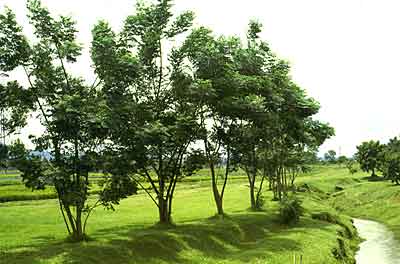About Neem
"Neem may be the harbinger of a new generation of "soft" pesticides that will allow people to protect crops in benign ways."[V23]
Neem oil is an active ingredient of a number of products cited for chinch control in the U.S. Neem has been registered for pesticidal use in the U.S. since 1985. Neem is not registered for use in Canada.
Neem oil is derived from the neem tree (Azadirachta inidca) which is native to arid regions of India. Its pest-repelling qualities have been known for thousands of years. Neem has negative effects on nematodes, snails, crustaceans, and fungi as well as on insects.
Neem trees on rice paddy bunds (dykes) in the PhilippinesIngredients
The main ingredients in neem oil that act against insects are alcohol soluble limonoids, of which azadirachtin accounts for most of the effects on insects. The residue from alcohol extractions, labeled 'Clarified Hydrophobic Extract of Neem Oil', has fungicidal properties. (Limonoids are important constituents of citrus juice). Azadirachtin does not kill most pests immediately[V23] but acts as an insect hormone mimic and interferes with the normal life cycle of insects including feeding, molting, mating, and egg laying.[V21]It has both contact and systemic action. It degrades rapidly in sunlight and within a few weeks in soil.[V26]
Neem's Mode of Action
Source: Neem: A Tree for Solving Global Problems. Report of an Ad Hoc Panel of the Board on Science and Technology for International Development National Research Council. National Academy Press, Washington, D.C. 1992 (see Link below)Effects on humans
Neem oil is considered very safe for humans (oral LD50: 13,000 mg/kg compared to 50 for nicotine, 200 for pyrethrum OLKC12) neem oil has been used on skin, in toothpaste, and medicinally and as a grain protectant. [V21, V26]Effects on non-target organisms
"Beneficial Insects Neem seems remarkably benign to spiders, butterflies, and insects such as bees that pollinate crops and trees, ladybugs that consume aphids, and wasps that act as parasites on various crop pests. In the main, this is because neem products must be ingested to be effective. Thus, insects that feed on plant tissues succumb, while those that feed on nectar or other insects rarely contact significant concentrations of neem products." [V24]. IPM Alaska notes that being an oil, it can affect beneficial insects when sprayed on them. however once dried it has little effect on them.[V26]At the, levels of neem that enter aquatic systems in forest spraying, it seems it seems not to have substantive effects on aquatic insects, however, crustaceans (zooplankton) have been found to be very sensitive to neem and this is a concern.
In the US, product "labels direct users not to apply the products directly to water, not to contaminate water during cleaning or disposal activities, and not to apply when honeybees are actively foraging."[V21B]
Links
- Neem Oil (www.ipmofalaska.com/files/neem.html) IPM Alaska, Spons. (Viewed 15 Apr. 2004).
- Neem: A Tree for Solving Global Problems (1992) (http://books.nap.edu/books/0309046866/html/R1.htm) NATIONAL ACADEMY PRESS (Washington, D.C. ), Spons. (1992. Viewed 20 May, 2004).
Text from this book which is a Report of an Ad Hoc Panel of the Board on Science and Technology for International is available for viewing online.
Page posted 5 May 2004
Page modified 29 Nov. 2004.
